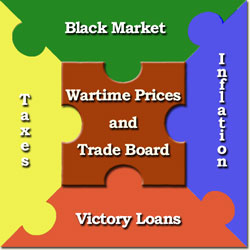The Wartime Prices and Trade Board
Within the first two years of the war, inflation was running at 17.8 percent. The government, not wanting it to get out of control
(as it had in World War One) put in place The Wartime Prices and Trade Board in the fall of 1941. The board, under the Department
of Finance, had the power to set and control prices for goods and services, and to set wages. As soon as the board was formed it
put price ceilings in place. The price that could be charged for a good or service was based on what it had cost between 15
September and 11 October of 1941. Over the duration of the war the price could go no higher but it could go lower. During the rest of the war, inflation only rose 2.8% further.
If the
board wanted it could reduce the top price of a good or service. Price controls were taken off slowly after the war to keep the
post-war economy stable.
FINANCING A WAR
War is expensive. Governments must raise large amounts of money or capital to finance a war effort. When Canada entered World War II she was ill prepared for battle. The permanent military forces only numbered approximately ten thousand men and the little equipment they had was of World War One vintage. Canada needed money fast to finance the production of war equipment and the running of the war machine - she looked to her own people.








